A Guide to Multi-Chain Yield Farming

Dear Bankless Nation,
We live in a multichain world.
But then again, we always have.
Coinbase, Gemini, Binance, Kraken—these are just centralized sidechains that use chains like Ethereum and Bitcoin for asset registry and settlement.
What’s new is the number of non-Ethereum “DeFi” chains with apps, yield, and users. I put “DeFi” in quotes for a reason. I’m skeptical if these chains are decentralized enough to warrant the title. Once again open finance is probably a better term.
Are they corruption-resistant enough to be the base layer of the world’s money system?
No, not yet…not from my perspective.
I also don’t think the world’s financial system will be based on Binance or RobinHood or Flow either. But that doesn’t mean they don’t have a role to play in crypto and DeFi. FinTech and crypto will blend together in 1,000 new ways this decade.
So what role are these non-Ethereum chains playing now?
They offer yields.
A savvy Bankless reader can collect that yield and turn it into any asset they prefer. USD, ETH, BTC…or something else.
Here’s what I said in a recent open thread:
Bankless will always cover bankless ecosystems, whether that's Bitcoin, Ethereum, or something else. But I'm personally way less interested in "DeFi" that's easily controllable at the base layer by neo-banking cabals. Discovering the difference is part of the bankless journey we're on and it's not easy.
We aren't backed by VCs. We're backed by values. So our aim is to be open minded on approaches and not blinded by bags, but also to remain resolute on values. Bankless is a thesis driven media company.
There's a version of crypto that's good for the world and there's a version that makes everything worse. We're fighting for the former.
Not Bitcoin Maximalist. Or Ethereum Maximalist. Bankless Maximalist.
Remember the protocol sink thesis. Remember why we’re here.
And also…have fun and enjoy the yields!
- RSA
P.S. If you’re into sports collectibles, you should check out SoRare. It’s the biggest platform for trading official football player cards (soccer for Americans!).
A Guide to Multi-Chain Yield Farming

We live in a multichain world.
As high gas fees on Ethereum continue to persist, yield-hungry users have been forced to look elsewhere in the neverending quest for returns. An ape needs to eat.
Fortunately, there are several networks well-positioned to help absorb crypto natives' ravenous appetite for using these systems by providing them with cheaper and faster transactions—albeit with lower security guarantees. The best part is that the applications, and sometimes even the network itself (or both), are offering substantial liquidity mining incentives for yield farmers willing to take the risk, make the move, and deploy capital into these newer systems.
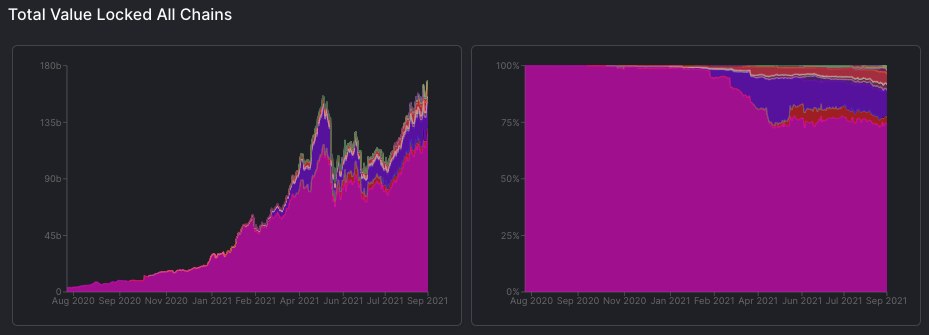
Below we’ll touch on a few of the opportunities available for farmers on three of the ecosystems currently experiencing the bulk of the growth: Avalanche, Solana, and Terra.
These are certainly not the only opportunities—or even the highest-yielding. But given that many protocols in these systems are extremely early and less battle-tested, the ones listed intend to strike a healthy balance between risk and reward.
As always, please ape responsibly!
1) Avalanche Yield Opportunities
The Avalanche ecosystem has experienced tremendous growth in recent weeks.
The network has seen value locked explode from $339 million to $2.2 billion in less than three weeks, catalyzed by the announcement of Avalanche Rush—a $180 million liquidity mining program. The program will soon feature solid incentives on staple Ethereum DeFi protocols like Aave and Curve.
To go along with a surge in the price of AVAX and Avalanche DeFi tokens, there are numerous high-yield opportunities for savvy farmers willing to cross the bridge and take advantage of fast confirmations and significantly reduced gas fees, which only range from $0.50-$2.00.

🚆 Onboarding to Avalanche
As an EVM-compatible chain, onboarding to Avalanche is incredibly straightforward, as users simply need to just add the network to their wallet, and then bridge funds across from Ethereum.
- For a guide on how to add Avalanche to your MetaMask, click here
- To access the bridge between Ethereum and Avalanche, click here
Avalanche Opportunity #1: BenQi
- ROI estimate: 2-12% APY 💰
Given Aave has yet to launch on Avalanche, BenQi is the current king of the network’s money market sector. The protocol has experienced incredible growth, attracting over $1.21 billion in TVL in the two weeks since its launch. This emerging money market protocol has been a key driver in catalyzing the infusion of capital into the Avalanche ecosystem. BenQi currently features a $3 million liquidity mining program, where depositors and borrowers are incentivized to participate in the system through earning QI and AVAX rewards.
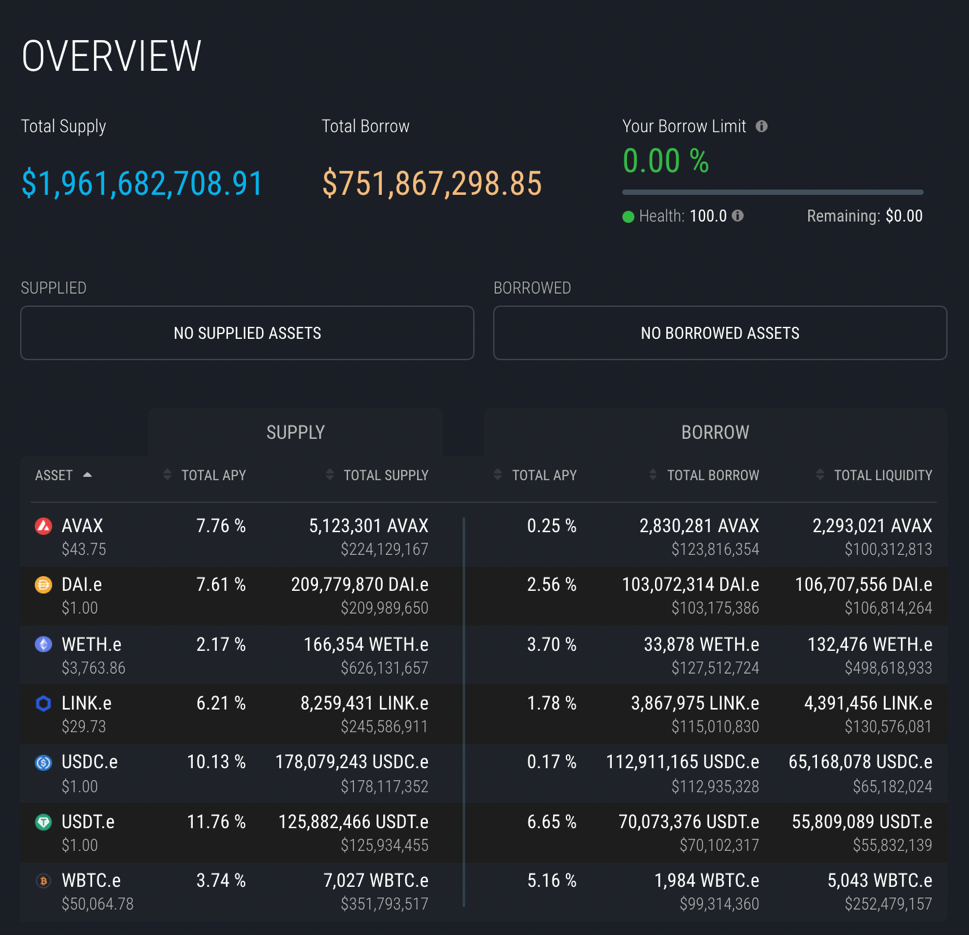
The protocol currently supports deposits and borrows for AVAX, wETH, wBTC, LINK, DAI, USDC, and USDT. It’s important to recognize that depositor yields range between 2.20-11.76% depending on the asset, with the yield consisting of a combination of interest and token rewards. On the other side of the market, borrowers can earn a net APY (rewards – interest) anywhere from 0.24% to 6.80%. This means that farmers can be paid to borrow, and enables a variety of different strategies.
For example, a wBTC holder can employ a strategy in which they deposit their tokens to earn 3.78% APY, which they can then use as collateral to borrow and earn 5.30% APY on their outstanding debt. This allows a farmer to earn a yield on their assets while minimizing liquidation risk, as the value of their debt will move in tandem with that of their collateral. (The more degenerate among us can recursively repeat this process.)
Avalanche Opportunity #2: Trader Joe
- ROI estimate: 20-85% APY 💰 💰 💰
Trader Joe is the largest decentralized exchange on Avalanche, holding over $455 million in liquidity and facilitating between $100-200 million in daily volume since August 23, notably surpassing the first-mover Pangolin in both metrics.
The protocol is currently incentivizing 23 different tokens pairs where liquidity providers can stake their LP tokens to earn JOE rewards, the DEX’s native governance token, along with a trading fee of 0.25% on every swap. These pairs vary dramatically in terms of asset composition, yield, and of course, risk, allowing farmers to express a variety of different viewpoints.

For instance, risk-averse farmers who do not want price or impermanent loss exposure can enter the USDC/DAI and USDT/DAI pools to earn a yield currently sitting between 23-24% APR.
Additionally, farmers who believe the market will be rangebound and are willing to take on some risk can earn between 29-86% APR in the wETH/USDT, wBTC/USDT, and AVAX/USDT pools. Finally, a farmer who’s willing to take on maximum price and impermanent loss exposure can earn upwards of triple-digit yields in some of the protocol’s riskier pools.
🧑🌾 Bonus Yield Opportunity
- JOE Staking—29% APR —Stake JOE to receive 0.05% of every swap in the form of xJOE tokens.
2) Solana Yield Opportunities
Solana is another ecosystem that has experienced strong growth over the past several months. Spurred by a rise in the price of SOL, new protocols launching on the network, a mini-NFT mania, and the adoption of Phantom Wallet, Solana has seen its TVL rise nearly 6x to $3.6 billion since July.
Even though it’s still in its early stages, with 500ms confirmations and sub $0.01 fees, there are several noteworthy opportunities for farmers to put capital to work.
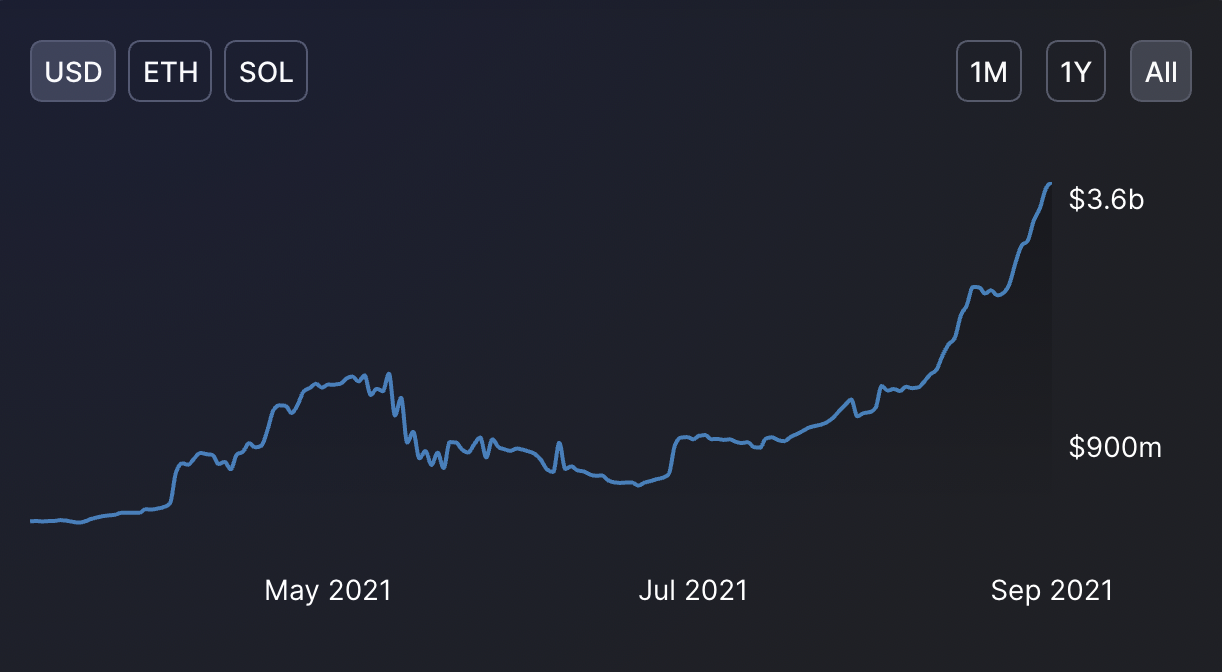
🚆 Onboarding to Solana
While not an EVM compatible chain, the process for onboarding to Solana is similar to that of Avalanche.
Rather than add the network to MetaMask, you’ll instead have to download a new web wallet. To get funds into the system, users can either go through a centralized exchange, or use a bridge such as Wormhole (It’s worth noting the bridge site recommends holding off on doing so until the deployment of Wormhole V2)
- To see a list of Solana web wallets, click here (Phantom recommended!)
- To access the Wormhole bridge between Ethereum and Solana (V2 is not yet live!), click here
Solana Opportunity #1: Raydium
- ROI estimate: 17-154% APY 💰 💰 💰
Raydium is the largest AMM on Solana, with over $1.35 billion in value locked and daily volumes north of $220 million dollars. Raydium is unique as it provides liquidity to Serum, a Solana-based central limit order book (CLOB) DEX. This means that traders can access liquidity in either protocol to get the lowest slippage for their trade, and LPs can boost their returns through Serum volumes.

Raydium provides two types of opportunities for yield farmers.
The first are “Raydium Farms” where liquidity providers for the RAY-SRM, RAY-ETH, RAY-SOL, and RAY-USDC, RAY-USDT pairs can stake their LP tokens to earn RAY rewards, to go along with a 0.22% fee on every swap.
These yields currently range between 66-117% APY depending on the pair, with RAY-USDC and RAY-USDT at the higher end of this spectrum, likely due to farmers pricing in the increased risk of impermanent loss these pools may incur in a trending market.
Raydium farmers can also enter “Fusion Pools,” which are incentivized trading pairs of other projects within the Solana ecosystem. There are currently 13 Fusion Pools, with prominent protocols such as Mango Markets, Mercurial Finance, and Cope incentivizing the MNGO-USDC, MER-USDC, and COPE-USDC pairs with their native governance token respectively. These pools are currently yielding between 17-154% depending on the token, but of course, come with increased risk of impermeant loss.
🧑🌾 Bonus Yield Opportunity
- RAY Staking—20% APR—Stake RAY to earn 0.03% of every trade made on the platform in the form of additional RAY tokens.
Solana Opportunity #2: Saber
- ROI estimate: 28-34% APY 💰 💰
Saber is a decentralized exchange that’s optimized for trading between like assets, as well as for facilitating cross-chain swaps by routing liquidity across token bridges. The protocol has attracted over $897 million in liquidity, which like its EVM-based competitor Curve, provides LPs with a way to earn a yield while minimizing the risk of incurring impermanent loss.
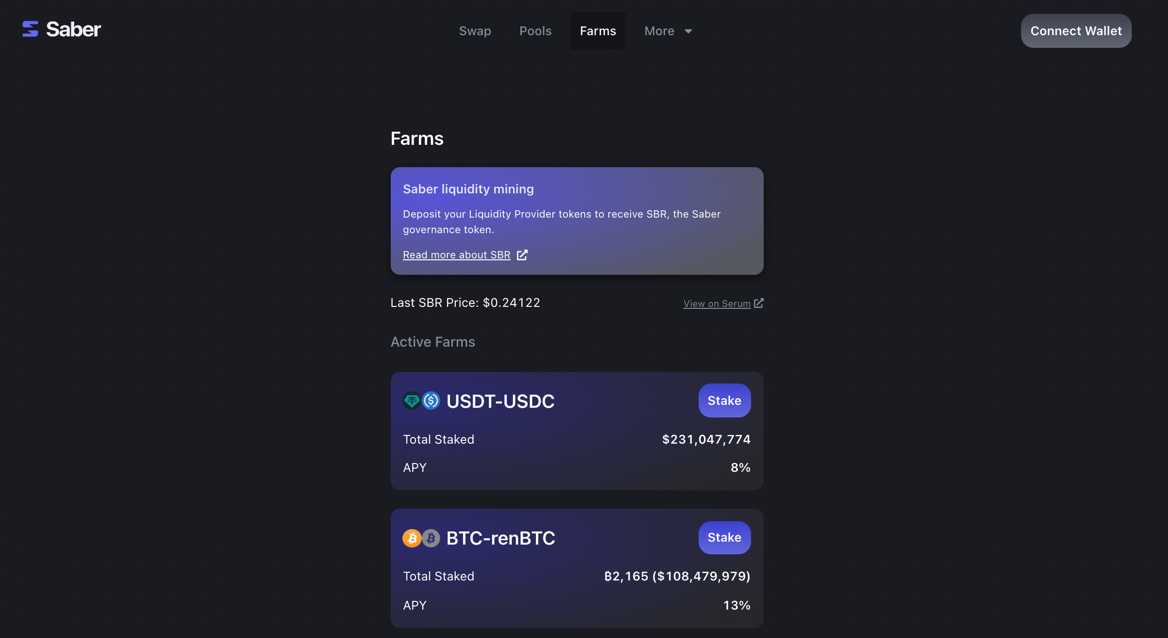
Saber is currently incentivizing 18 different pairs with SBR rewards, which depositors can earn in addition to a 0.04% swap fee on trades made within the pool. While each differs in its exact composition, they can largely be placed into three distinct groups: stablecoins, Bitcoin, and non-Bitcoin assets.
The highest yielding in each category are the MAI-USDC, pBTC-renBTC, and wLUNA-renLUNA, which are earning liquidity providers 34%, 28%, and 29%, respectively.
An important factor to keep in mind with Saber are that some pools have withdrawal fees. For instance, the USDC-USDT pool charges liquidity providers wishing to exit 0.5% to remove their capital, meaning that farmers are operating at a loss until they recoup that fee!
3) Terra Yield Opportunities
Terra is yet another smart contract ecosystem that has experienced incredible growth. Fueled by a rise in the price of LUNA, adoption of UST, the network's native stablecoin, and the strong product-market-fit of its applications, Terra is now home to crypto’s third largest DeFi ecosystem.
With over $7.53 billion in value locked, the chain places behind only Ethereum and Binance Smart Chain. While there are fewer prominent applications on the network than Avalanche, there are still several stellar opportunities for farmers.
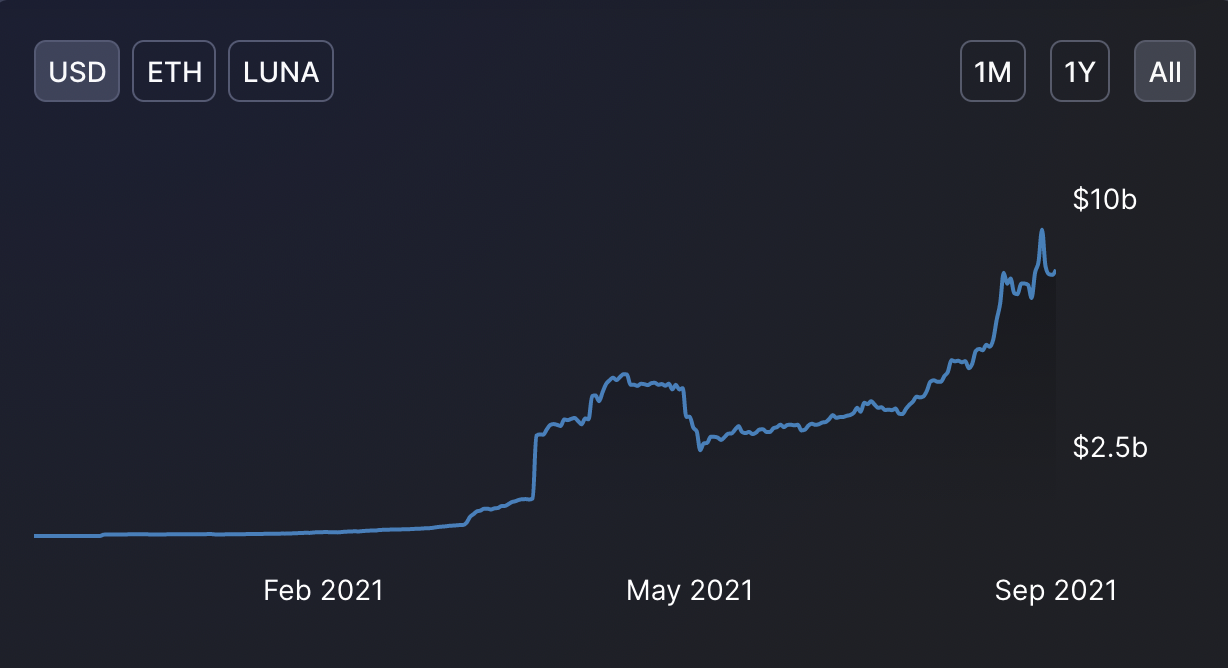
🚆 Onboarding to Terra
Like Solana, Terra is not an EVM compatible chain. That said, the onboarding process is similarly simple, as users just need to download a Terra compatible wallet, and then bridge funds over from Ethereum or another network.
- To see a list of different Terra wallets, click here
- To access the bridge between Etherem, Terra, and Binance smart chain, click here
📡 For more on how to download Terra Station, check this guide out!
Terra Opportunity #1: Anchor
- ROI estimate: 12-38% APY 💰 💰
Anchor is the leading money market on Terra, with more than $2.72 billion in value locked. The protocol utilizes a novel design that pays out a fixed interest rate to UST depositors and enables the use of staking derivatives as collateral to borrow said UST.
Through a process known as bonding done via the protocols interface, borrowers can use their LUNA to mint an identical amount of bLUNA, which can then be used as collateral within Anchor (worth noting that there is a 21-day wait to unbond LUNA!). In addition, the protocol also supports bETH, a Terra-wrapped version of Lido’s staking derivative, stETH, as collateral within the protocol.
🧠 To get an in-depth description of how Anchor works and the mechanics behind generating the fixed yield for depositors, click here.
Albeit with the risk of liquidation, borrowers can earn a net APR of 12.9%, which is derived from a 38.3% yield from ANC rewards and a 25.4% borrow APR. Currently, the yield paid out to UST depositors sits at 19.4% APY, just below the protocol's 20% target.
It’s worth highlighting that Anchor can serve several different roles for yield farmers.
For starters, risk-averse farmers can lock in a fixed yield on their stablecoins at a rate far higher than that seen on other money markets such as Compound and Aave. An additional strategy that a farmer can pursue would be to deposit bLUNA or bETH as collateral, borrow UST, and then redeposit UST into the protocol. This would allow a farmer to earn a 12.9% yield on their collateral, as well as a fixed 19.4% yield on their outstanding borrowers. However, it should be noted this strategy is inherently risky as it introduces the threat of liquidations.
Terra Opportunity #2: Mirror
- ROI estimate: 27-99% APY 💰 💰 💰
Mirror is another leading application on Terra that provides lucrative farming opportunities. A protocol for minting and trading synthetic assets currently holding over $1.46 billion in value, users can deposit UST as collateral to generate one of 28 different mAssets supported by Mirror.
These include stock market indices such as mSPY, equities like mAMZN, commodities including mGLD, and crypto assets mBTC and mETH. Liquidity for the trades is routed through Terraswap, the network's largest AMM.
There are two types of farming opportunities for Mirror participants.
The first is long farms, where users can provide liquidity to mAsset pairs and earn trading fees along with additional MIR rewards. The yields span from 27% APR on synthetic crypto assets like mETH to as high as 48% APR on equities like mHOOD, a synth of Robinhood stock.
The second is short farms, where farmers can use UST, aUST (UST deposited within Anchor) LUNA, or another synth, as collateral to mint another mAsset in the form of an sLP token. This sLP token is automatically staked by the protocol to earn its holder MIR rewards. Currently, the yield on short farms ranges from as low as 0.3% APR on mAMZN to 99.6% APR on Google, with most sitting between 30-40%.
Closing Thoughts
It’s apparent that DeFi has gone multi-chain. After juicing these new ecosystems with tokenized incentives over the past few months, there are now billions of dollars locked away, powering these emerging crypto economies.
But it’s still early for all of these ecosystems. For those looking to take the risk to explore these multi-chain opportunities, there are certainly rewards for it. Better yet, you get to experience DeFi without the insane gas fees that currently exist on Ethereum. Anyone can swap, deposit, lend, borrow, and everything else for a few cents or dollars with virtually instant transaction confirmations.
That said, Ethereum’s Layer 2 ecosystem is knocking at the door. With Arbitrum’s recent mainnet launch and Optimism close behind, users get to access the same fast & cheap transactions—all with Ethereum’s security guarantees.
We should expect that these Layer 2 protocols will run the exact same playbook that’s succeeding for competing Layer 1s. Therefore, we can only imagine it’s going to get competitive, and the yields might get crazy.
But guess who will win?
The users :)
Action steps
Explore multi-chain yield farming opportunities
Download the main wallets for each chain!
Avalanche: Metamask (add RPC)
Solana: Phantom
Terra: Terra Station